Shep Hyken's Blog, page 146
June 13, 2018
Your Brand is Defined by the Sum of All Your Customer Interactions
 What does a good customer experience look like at your company? What does good customer service look like? Ask everyone on your team and listen to the answers. Will they be the same, or different? It will be interesting to see if your team recognizes the difference between experience and service.
What does a good customer experience look like at your company? What does good customer service look like? Ask everyone on your team and listen to the answers. Will they be the same, or different? It will be interesting to see if your team recognizes the difference between experience and service.
Many people don’t understand the difference between customer experience and customer service, but does it really matter. That said, experience, when it comes to business, is the entire experience. While it includes customer service, which is a big part of the overall experience, it is also how your offerings are packaged, your advertising and marketing messages, and more. As mentioned, it’s the entire experience. It’s every interaction, human or otherwise, that you have with the brand.
Then there is the definition of customer service. Sure, it may be the “department” that customers go to when they have a problem, but it also includes every contact the customer personally has with anyone they encounter in your company. It’s focused on people interacting with people. There’s more to it than that, but for this conversation, let’s stick with these simplistic definitions.
As mentioned, knowing the difference between service and experience really doesn’t matter. What’s important is for everyone to know how they contribute to the customer’s experience. Some employees interact directly with the customer. They help drive the customer service, which as mentioned, is also a big part of the customer experience. Then, some employees don’t have any interaction, but what they do behind the scenes impacts the customer’s experience. It is important for every employee to know the role they play in the customers.
All of this is leading to the concept of your brand and its reputation. I recently had a chance to sit down with Brian Chaput, the director of Offering Management at IBM, and he made a statement that summarizes all of this. “Your brand is the sum of all your customer interactions.” In just ten words he nailed it! That’s experience and service, all rolled up into one. And the outcome is the perception of your brand’s reputation – and everyone has a supporting role in that perception. Everyone has some impact, in some way, on the customer’s experience.
So, does everyone in your organization know how they fit into the customer experience? Are they on the front line, delivering service directly to the customer? Are they behind the scenes, doing something that impacts the customer experience? There is customer service and customer experience. Sometimes they are the same, and sometimes they aren’t. But, to the customer, it doesn’t matter.
Shep Hyken is a customer service and experience expert, award-winning keynote speaker, and New York Times bestselling business author. For information, contact 314-692-2200 or www.hyken.com. For information on The Customer Focus customer service training programs, go to www.thecustomerfocus.com. Follow on Twitter: @Hyken
customer service training programs, go to www.thecustomerfocus.com. Follow on Twitter: @Hyken
The post Your Brand is Defined by the Sum of All Your Customer Interactions appeared first on Shep Hyken.
June 12, 2018
Amazing Business Radio: Jackie Gonzalez
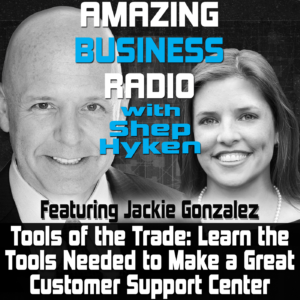
Tools of the Trade: Learn the Tools Needed to Make a Great Customer Support Center
Discover the best tools and software to provide a great customer experience.
Shep Hyken sits down with Jackie Gonzalez, Vice President of Operations at PATLive to discuss the best tools and methods for a customer support organization.





Top Takeaways:
First, some background on PATLive. Some third-party support centers employ thousands of agents, many of whom are overseas. PATLive agents, however, are all located in Tallahassee, Florida. These agents are trained to be like employees of the companies they represent. They provide their clients’ customers with a personalized experience.
Before choosing a tool or software for a support service, an organization must evaluate it for functionality, cost, difficulty, security standards, and other objective factors. With how much tools have changed, however, there are more higher-level factors to consider, including a balance between a tool’s functionality and the message and brand of an organization.
Evaluating the internal tools in addition to the external tools is very important. If the internal tools being used are outdated or difficult to use, it creates a negative in-house operation and frustrates employees. These frustrations can, in turn, lead to a negative customer experience.
Gonzalez shared eight tools PATLive uses that have improved their support center operation:
KnowledgeOwl: a knowledge management tool that keeps internal information organized in one place
Articulate 360: lets trainers quickly create online courses that are used to train employees
Slack: allows for easy communication and collaboration between team members
Trello: a project management tool allowing team members to organize and prioritize information
LiveChat Inc.: a live chat software tool allowing agents to chat with customers
Formstack: allows anybody to create an online web form to collect information and convert into workflows
Sprout Social: a social media management tool
Tresta: a phone system that records calls for quality assurance purposes
Though tools are necessary for customer support, you cannot let tools get in the way of creating a good employee and customer experience. To engage another person on a personal level, the tool should just be in the background for additional support. Traditional customer service principles must be the priority.
Quotes:
“The employee experience is almost more important, because it trickles right on down the line to the customer.” – Jackie Gonzalez
“More and more customers are moving towards social media and chat tools for customer support.” – Jackie Gonzalez
“Never let the tool rule.” – Jackie Gonzalez
“Regardless of the technology tools we use, at the end of the day, I am still a person and my customer is still a person, and I am still trying to engage that person on a personal and emotional level.” – Jackie Gonzalez
About:
Jackie Gonzalez is the Vice President of Operations at PATLive, the number one rated answering service since 1990. PATLive has a team of live receptionists who ensure great customer service.
Shep Hyken is a customer service and experience expert, New York Times bestselling author, award-winning keynote speaker, and your host of Amazing Business Radio.
This episode of Amazing Business Radio with Shep Hyken answers the following questions … and more:
How do you train customer service agents?
What tools are best for customer service agents?
What customer service tools are best for call centers?
What criteria should be considered when evaluating customer service software and tools?
How do tools and software affect an organization’s brand?
How can software help customer service agents provide better support?
How can you stay engaged with your customers?
The post Amazing Business Radio: Jackie Gonzalez appeared first on Shep Hyken.
June 11, 2018
5 Top Customer Service Articles For the Week of June 11, 2018
Each week I read a number of customer service and customer experience articles from various resources. Here are my top five picks from last week. I have added my comment about each article and would like to hear what you think too.
Delivering Remarkable Experiences Is How You Win More Customers by Sonia Thompson
(Entrepreneur) Equip your team to make a lasting impression.
My Comment: Sure… Deliver a remarkable experience and you win more customers. Common sense. But, what I like about this article is that it focuses on three simple ideas. (By the way, simple does not always mean easy). 1. Trust your employees. 2. Create great customer events. 3. Deliver relevant and valuable content. Great ideas for creating a remarkable experience!
Customer Loyalty is Not the Same as Repeat Business by Joseph Michelli
(Joseph Michelli) Given the confusion that abounds between loyalty and repeat business, I thought I would share a couple of nuances that I hope will prove conceptually helpful.
My Comment: I’ve always believed that customer retention is about repeat business, which is transactional. People confuse repeat business with loyalty. They are not the same. Loyalty includes repeat business, but more than a transaction, it includes an emotional connection. Joseph Michelli is one of my favorite experts in the customer service and CX space, and I always enjoy his articles.
How You Can Cultivate the One Thing Customers Truly Want by Peter Daisyme
(Entrepreneur) Every company wants to drive customer loyalty, but many neglect the fact that what customers want is community.
My Comment: While we’re on the topic of loyalty, one way to drive more customer loyalty is to create a community for your customers to be a part of. Finding ways to bring them together, either as a group of valued customers or to rally around a cause, creates a connection that drives loyalty. Here are three tips to help you do exactly that.
Team-Building Tips: 8 Ways to Make Sure Every Employee Feels Included by John Rampton
(Entrepreneur) People take jobs for a paycheck but they only keep jobs when they feel valued and part of a team.
My Comment: We always want our customers to feel good about us. Well, how about our employees? (That’s a rhetorical question.) Here is a great list of eight tips to make your employees feel like they are valued and part of a great organization. Happier employees mean more engaged employees, which is good for the customer and the company.
10 inspiring podcasts to level up your customer experience on-the-go by Zarina de Ruiter
(CX Network) Podcasts are more popular than ever before, but what are the best series to get stuck into for CX and leadership inspiration?
My Comment: Let’s wrap up this week’s Top Five with a list of great customer experience podcasts you may want to listen to. I’ve listened to many of these and am a big fan of several of the hosts. If you want to increase your knowledge and expertise in the CX world, you can’t do wrong to take time to listen to an episode or two (or many) from these excellent resources.
Shep Hyken is a customer service expert, professional speaker and New York Times bestselling business author. For information on The Customer Focus customer service training programs go to www.TheCustomerFocus.com. Follow on Twitter: @Hyken
customer service training programs go to www.TheCustomerFocus.com. Follow on Twitter: @Hyken
The post 5 Top Customer Service Articles For the Week of June 11, 2018 appeared first on Shep Hyken.
June 8, 2018
Guest Blog: Exceptional Customer Support Is Fresh, Not Canned
This week we feature an article by Daphne Kasriel-Alexander who tells us how to create mega-fans who can then become your biggest advocates. – Shep Hyken

Meet Mor and Yoni, two of the Lightricks support team all-stars.
Ever been put on hold for three hours? Forced to listen to fake-happy ‘customer care’ puppets reading from scripts? The dissatisfaction you’ll be left with goes both ways: the cost of disappointed customers is high for companies, too. Research reveals that 19% of consumers will never forget — or forgive. After just one bad customer support experience, trust in a brand is gone forever. 25% of us will switch to the next-best choice and 30% are quick to share experiences that left a bad taste.
It doesn’t have to be this way. Consumer empowerment (social media has consumers publicly sharing stories about buying experiences) is diluting customer loyalty to brands and raises expectations about post-purchase support. Our methods are tried-and-true: we get over 2500 queries a week.
Stay away from scripts
Aim to offer a fresh response to each email, message, or request. We’re Lightricks, by the way, a company that’s behind the Enlight suite of creative apps on iOS: Photofox, Quickshot and Videoleap. Users of our photo and video editors are looking to actualize all sorts of unique ideas visually and they come with many questions (hundreds every day). The worst thing you can do? Respond with an automated reply, directing them to an FAQ that probably needs an update, anyway.
“We’re so against canned responses. We like people to know we’re also people.” That’s Mor, who heads the Lightricks Support Team. You’ll see her in action a bit later.
Your customers are moved by honesty
If you’re upfront and admit your faults (we’re human after all), you will turn angry customers into loyal fans who respect you. Over Christmas, our Quickshot app was released with a bug that affected many users. Without skipping a beat, we posted about it on social media.
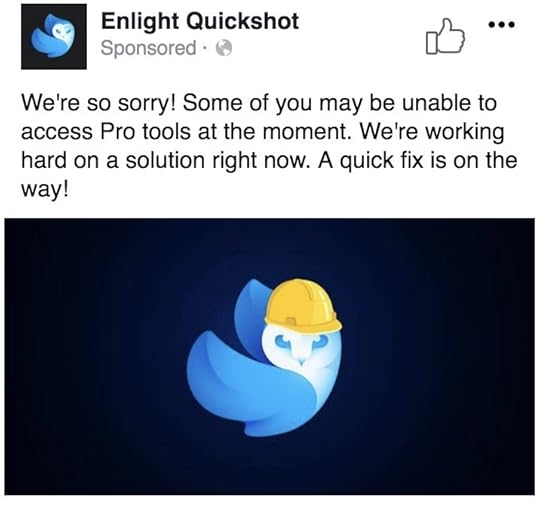 We then kept users updated via email and later sent them an Amazon gift card for their inconvenience.
We then kept users updated via email and later sent them an Amazon gift card for their inconvenience.
 Responses like this one are pure gold!
Responses like this one are pure gold!
Today’s customer support landscape is more than just email
In 2018 customer support spans so much more than help@yourcompany.com. Multiple communications channels will make it easier for your customers: feedback buttons within products, tweeting, DM’s, the inevitable Facebook wall. Put together a team who can take care of issues across all channels, who knows that customer perceptions are fragile, can be screenshot-ed (!), and can change with each interaction. See social media as proactive support. When you respond to users posting informally on social media, you’re also publicly sharing tips with others who may learn from them too.
 Embrace the new
Embrace the newChoose novel ways to clarify things for product users. Our support team, itself operating in a creative, startup environment, takes advantage of innovations to tailor replies to users. iOS 11, for instance, came out with a screen recording feature. When our users ask how to combine photos in Photofox (our artistic photo editing app) or ask something as simple as how to change settings, we started attaching a personalized screen recording to accompany our explanation. Sometimes we’ll host live sessions, offer support live in real-time.
 Open up channels of communication
Open up channels of communicationMake customer requests an integral part of upgrades and new products. We learn the strengths and weaknesses of our products this way. Consistent meetings between the support team and whoever’s responsible for building your product will wax beneficial to all parties involved: the support team, product team and your customers.
“We’ll pass complex questions or user confusion on to our creative team,” says Yoni, another one of our support all-stars. “ Many requests end up being ‘translated’ into new social media content to help others.”
Still not sure?
Here’s an upbeat case study. It’s the story of how our support crew listened to the users of Videoleap, our creative video editor (and Apple’s App of the Year in 2017 in 77 countries, only three months post-launch — ok, done gloating).
Speed controls — ability to slow down or speed up video — were the missing ingredient for many, and a user chorus asked for it to be added to the app’s tool arsenal. Product developers made this a priority and rolled out the feature in February 2018. But the story didn’t end there. Each of the hundreds of users who had speed controls on their wishlist was then sent a personalized update, with a tutorial on how to use the feature. User lover blossomed:
Moving from fans to brand ambassadors
There’s more to look forward to. When you have raving fans, they tend to become your best advocates. We’ve seen case after case of frustrated-user turned satisfied-and-happy-fan turned knight-publicly-defending-our-honor against online critics. When a third party (read: not you) jumps in to publicly defend your brand, your work here is done.
The best way to create mega-fans is to give them a great experience and help them become really, really good at using your products. This kind of customer support will guarantee your end goal — more sales. Need more examples? We’ve got tons…
Daphne Kasriel-Alexander is a content writer at Lightricks zooming in on what’s interesting about startup life, tech culture and design trends.
For more articles from Shep Hyken and his guest contributors go to customerserviceblog.com.
Read Shep’s latest Forbes Articles: Whole Foods Knows Its Customers. Do You Know Yours?
The post Guest Blog: Exceptional Customer Support Is Fresh, Not Canned appeared first on Shep Hyken.
June 6, 2018
All Customers Are Created Equal – Just Some Are More Equal than Others
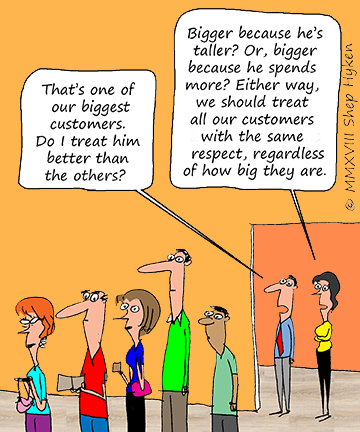 In 1945 George Orwell published the literary classic, Animal Farm, which was required reading in my middle-school English class. I always remembered the line: All animals are created equal, just some animals are more equal than others. Someone recently referenced the book and this famous line, and it made me think about how customers are treated.
In 1945 George Orwell published the literary classic, Animal Farm, which was required reading in my middle-school English class. I always remembered the line: All animals are created equal, just some animals are more equal than others. Someone recently referenced the book and this famous line, and it made me think about how customers are treated.
Are all customers equal? Loyalty programs promote perks, rewards, elite status and more, which might suggest that not all customers are equal. Now, I agree that loyal customers can receive some type of reward or discount for their loyalty. But, what about when it comes to customer service? What about how customers who spend more – or less – are treated? Should a frequent or loyal customer be given better customer service than a casual, once-in-a-while customer, or even a first-time customer?
The short answer is no. We’re not talking about perks here. Just about the way a customer is treated. Here’s what I recently observed. By the way, I’m sure this isn’t any different behavior that has been going on for a long time, it’s just lately I’ve been acutely aware of it. I was at a restaurant and noticed a guest was almost being ignored compared to another guest at the next table. I inquired about who that “special” person was getting the extra attention, and my server said, “He’s in here all the time.”
I notice the same type of behavior happens with airlines and hotels. It’s easy to spot the frequent traveler by the way they are treated by airline and hotel employees.
So, it appears that frequency might warrant a better customer experience. The same might go for how much a customer spends.
Here’s my take:
The way a customer is treated should have nothing to do with how much they spend or how often they buy. All customers should be all be treated with dignity, respect and the attention any human deserves. They should all be treated in a way that is consistent with your brand promise and the reputation you wish to be known for. Now, when it comes to the perks you might offer a loyal customer, you can differentiate. That’s different than the way you treat them.
But, isn’t it human nature to treat the regular and more profitable customers a little better? If that is what you believe, there is a solution. If you haven’t already done so, create a minimal standard of customer service. This standard should be so good as to garner high praises regardless of how much – or how little – the customer spends. It’s that simple.
So, remind everyone of the standards you want to be known for. Remind them that applies to all customers, not just the ones they see more frequently. Do that and you may start to see more casual customers become repeat customers. You see, all customers are equal, just some are more loyal than others.
Shep Hyken is a customer service and experience expert, award-winning keynote speaker, and New York Times bestselling business author. For information, contact 314-692-2200 or www.hyken.com. For information on The Customer Focus customer service training programs, go to www.thecustomerfocus.com. Follow on Twitter: @Hyken
customer service training programs, go to www.thecustomerfocus.com. Follow on Twitter: @Hyken
The post All Customers Are Created Equal – Just Some Are More Equal than Others appeared first on Shep Hyken.
June 5, 2018
Amazing Business Radio: Melissa Agnes
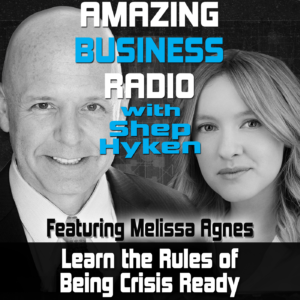
Learn the Rules of Being Crisis Ready
Are you ready for a customer service or brand crisis?
Shep Hyken discusses handling and preparing for a customer service or brand crisis with Melissa Agnes, the author of Crisis Ready: Building an Invincible Brand in an Uncertain World.
>





Top Takeaways:
Melissa explains that ever since she was a kid in Montreal, she’s had the ability to spot and mitigate potential risk. This skill came into play ten years ago when social media first began to rise. While everyone was talking about how great social media was, her mind immediately thought of the risks it presented. She calls this her “a-ha” moment.
Being “crisis ready” means:
The entire organization knows what risk looks like and how to detect it.
They understand how to assess the impact of risks on their brand: is it a crisis or is it an issue?
They can manage the crisis in a manner that still builds stakeholder trust and credibility.
A crisis is a negative event stopping business-as-usual because it extends to the top of the organization and has potential long-term negative impact on people, the environment, business operations, the organization’s reputation, and/or the organization’s bottom line. An issue, however, does not have the risk of a long-term impact. While an issue can go viral, it does not necessarily become a crisis.
Crisis Response Penalty (CRP), a term coined by Melissa, looks at the short-term and long-term monetary and reputation impact a crisis has on a brand due to that brand’s poor and ineffective response. The longer it takes for a business to provide an effective response, the more credibility and trust you lose, the more control of the narrative you lose, and the higher CRP you have.
In order to become crisis ready for something that has not occurred before, Melissa says though we cannot predict exactly how a situation will happen, we can consider the possibilities of a high-risk scenario where an employee goes rogue or does something wrong that can potentially go viral. For example, an employee may be involved with a sexual harassment issue or make an inappropriate response to a social media post. Additionally, taking societal trends into consideration, including the staggering amount of racial discrimination occurring in retail, coffee shops, etc., allows business to know the likelihood that something will go wrong or against the brand’s values.
To respond to a crisis in a way that is emotionally intelligent, a business must put people first.
There is no circumstance when “no comment” is an acceptable response. It goes completely against putting the customer first. A “no comment” response can lead to mistrust and cause customers to choose another brand. If you are crisis-prepared, you already have a comment ready.
Quotes:
“One of the crisis ready rules is always assume there is video.” – Melissa Agnes
“A fast response is the best response, if it’s an emotionally intelligent response.” – Melissa Agnes
“What does ‘no comment’ say? ‘No comment’ says we don’t care about you enough to put you first, to communicate with you.” – Melissa Agnes
“People understand laws, they understand regulations, they understand restrictions. What they want to know is that you care.” – Melissa Agnes
About:
Melissa Agnes is a leading authority on crisis management and preparedness. Her book, Crisis Ready, published in March 2018, details how organizations can implement a crisis ready culture.
Shep Hyken is a customer service and experience expert, New York Times bestselling author, award-winning keynote speaker, and your host of Amazing Business Radio.
This episode of Amazing Business Radio with Shep Hyken answers the following questions … and more:
What does it mean to be “crisis ready”?
What is the difference between an issue and a crisis?
What is a crisis response penalty?
How can your business prepare for a potential crisis?
How do you become crisis ready for something that has never happened before?
How long should you wait to respond to a crisis?
Is it ever okay to say, “no comment”?
The post Amazing Business Radio: Melissa Agnes appeared first on Shep Hyken.
June 4, 2018
5 Top Customer Service Articles For the Week of June 4, 2018
Each week I read a number of customer service and customer experience articles from various resources. Here are my top five picks from last week. I have added my comment about each article and would like to hear what you think too.
Stop Trying to ‘Delight’ Customers, Says CX Expert Paul Greenberg by Noreen Seebacher
(CustomerThink) Known in customer relationship management (CRM) circles as the “Godfather of CRM,” Greenberg suggests businesses are better off consistently meeting their customer’s expectations.
My Comment: The title might surprise you; “Stop Trying to Delight Your Customers.” The concepts of “delight” or “ going above-and-beyond” are reserved for specific opportunities, such as a special occasion or a service failure. Most of the time, service should be friendly and engaging. The goal is to be, at a minimum, a little better than average – all of the time. And, once in a while, when the opportunity presents itself, go for “above and beyond.” To me, that’s what “delight” is about.
How Companies Can Identify Racial and Gender Bias in Their Customer Service by Alexandra C. Feldberg & Tami Kim
(HBR) In April 2017, United Airlines encountered public outrage when an Asian passenger was dragged out of his seat and off of an overbooked United Airlines plane. Then, almost exactly one year later, two black patrons were arrested at a Starbucks store for sitting at a table without having made a purchase. Both events were recorded, uploaded to social media, shared widely, and broadly condemned as instances of racial bias.
My Comment: With the recent racial bias Starbucks incident, this is a very appropriate article to not just read, but study and use. There are a number of good ideas that will help your organization be more inclusive and diversified. A hot topic that warrants your attention.
Why Great Customer Service Doesn’t Cut It by Adam Butler
(Forbes) What do I mean when I say great customer service doesn’t cut it? Isn’t great customer service one of the top selling points of any successful business? The answer is, not exactly.
My Comment: The title should grab your attention. Great customer service, by itself, doesn’t cut it. And, the concept of “great customer service” is becoming a hallowed promise for some companies. Furthermore, in some cases, customer service has become a commodity. It is expected. However, certain levels of service can make you stand out. The key is to know where to put your efforts.
3 Ways to Sweeten the Employee Experience by Kathleen Vegh
(CMSWire) While there isn’t a one-size-fits-all approach to developing an employee engagement plan, certain key initiatives can boost retention and improve work experiences — which also has a positive impact on customer satisfaction.
My Comment: Happier employees mean happier customers. It’s true. Stats and facts from numerous surveys show the best places to buy from are also the best places to work. This short article shows three ways to create a better employee experience that sets the tone for the customer experience.
Eight simple rules to keep customers (and mom) happy by Jay Robb
(The Hamilton Spectator) So picture your mom as a customer, client, student or patient where you work. Here are eight ways you can make her proud and win over the people who keep you in business.
My Comment: We wrap up this week’s Top Five with a book review of one of my favorite customer service books to come out this year. Jay Robb reviews “Make Mom Proud” by Jeanne Bliss and shares eight great tips from the book.
Shep Hyken is a customer service expert, professional speaker and New York Times bestselling business author. For information on The Customer Focus customer service training programs go to www.TheCustomerFocus.com. Follow on Twitter: @Hyken
customer service training programs go to www.TheCustomerFocus.com. Follow on Twitter: @Hyken
The post 5 Top Customer Service Articles For the Week of June 4, 2018 appeared first on Shep Hyken.
June 1, 2018
Guest Blog: Things to Consider Before Buying a Live Chat Software
This week we feature an article by Jason Grills who discusses the importance of integrating an effective customer support system and how to decide upon live chat software for your organization. – Shep Hyken

“Your most unhappy customers are your greatest source of learning” – Bill Gates, Microsoft Founder.
Every business aims to delight their customers. But do they always succeed in making their customers happy? Probably not.
There are times when customers come looking for an answer. Reason? Can be many. Some aren’t comfortable with the interface, some don’t understand the product well and need help, while others aren’t satisfied with the support services. This may sound harsh. But this is what you need to improve your existing products or services further.
So, what’s your next move? You’d probably try to reach out to them. Try inspecting all features or services that are responsible for hampering their user experience. This is where you need to ask yourself again, how do I go about this process?
The answer is simple. You need to integrate an effective customer support system, like a live chat software, to know your customers better. It can help your organization gain better benefits.
Benefits of Live Chat Integration
A live chat can help an organization learn what all areas it needs to improve and build a product/service that matches the needs of their customers. Other than that, there are many other benefits that are convincing enough for a business to invest in a live chat software.
Let’s take a look at some of the many benefits in detail.
1. Boosts Your Sales and Conversions
One of the major benefits your organization can reap from the use a live chat software is an increase in sales and conversions.
According to the American Market Association, 20% increase in conversions, on an average, was noted by B2B companies that use a live chat tool at their website.
That’s quite an outcome that shouldn’t be missed.
Website visitors are bound to raise questions about a particular product or service. Most won’t pick their phones to call your support agents and know the product in detail. This is when organizations need to provide instant help to stay market relevant. And, live chat tool gives you an opportunity to help visitors overcome their suspicions about your services and reach a purchasing decision.
2. Strengthens A Buyer’s Trust
Unlike a retail store, it is hard to build a rapport with visitors through an online platform. But with a live chat software, that too is made possible.
You can put a customer’s skeptical outlook at bay by having a direct conversation through the tool. It helps you build trust, and shorten the gap between offline and online purchases. This is well supported by a study from Oracle. According to the Global Consumer Trends, 90% consumers expressed how a live chat button gives them the boost, a confidence to approach an online platform and know the product better.
3. Increases Customer Satisfaction Ratings
Satisfying customer experience is what your target audience looks for when planning to approach you. You can go for email or call support. But what’ll help you maintain your customer satisfaction ratings is the use of a live chat software.
As per eDigital’s study, live chat is known to provide maximum customer satisfaction, with 73%, as compared to any customer service channel. This is because customers receive instant and personalized answers that’ll keep them glued to an organization’s services.
Besides this, you can also stay in constant touch with your website visitors and retain them as customers. In short, these benefits are convincing enough to buy live chat software.
But hold on. You can’t just buy any live chat software and integrate it into your website. It’s not just money but also your customers’ satisfaction level at stake. Don’t make a hasty decision while exploring various options available in the market.
In case you aren’t familiar with the factors that need to be considered before buying a live chat software, then the guide below can help you know them better.
Guide to Buying the Best Live Chat Software

Before finalizing an option, it is essential for you to understand your organization’s needs. There are various things you’d like to monitor and keep a track of regularly. Let’s take a look at them.
Monitor website visitors in real-time
Track your support agent’s performance
Increase lead generation
Boost overall sales
Monitor cart abandonment
Monitor support costs
Track real-time conversation and interrupt at any point that needs you to be present
While keeping these pointers in mind, you’ll have to search for a live chat software that helps you handle them all in one go. There are various options available in the market. So, choosing the right one can become a hassle. This is where live chat comparison technique will come in handy.
Short-listing is a tiresome task but not an impossible one to achieve. So, ensure that all the options at hand are compared on some of the following basis stated below.
Don’t Burn a Hole in Your Pocket!
Even though we live in a market that offers us many options in one go, still you’d be confused on “where to start?” point. This is where you first need to consider your budget.
No doubt you’re in need of live chat platform that helps you tackle all customer queries with efficiency. But never overlook your budget constraints. Look for live chat plans that fit within your budget. Once the growth is on roll, you can always think of shifting on to a better plan that gives you access to all premium features too.
So, never forget to compare live chat pricing before reaching a conclusion.
One That Meets Your Business’s Expectations
As discussed above, there are certain aspects that you’d like to monitor. For this, it is important that you invest in a live chat tool that has all those features and covers all your concerns easily. So, ensure to compare them all on the basis of their features.
Some common features that you’d find in a customer support software include:
Canned responses
Monitors client feedbacks and ratings
Comes with multilingual chat, therefore breaking language barriers
Track’s individual operator’s performance
Great to record offline messages
Chat window can easily be customized
Readymade templates for creating a custom chat box
Anytime, anywhere access to a mobile application
Boosts real-time communication
These in return help a business boost its sales and conversions. Therefore, proving to be a beneficial addition to the customer support system.
Client Reviews Do Matter
No doubt that signing up for a 15-days, no obligation trial may prove beneficial for you to know the product better. This will help you explore the product and understand whether it fits your needs or not.
In case you aren’t able to spare that time, try reading client reviews. They would help you get a better insight on what to expect from the product. Some even discuss what all issues they’ve faced before getting the set-up done, while they were using the software, and how well does the customer support agents have helped them resolve their questions.
Such an insight is essential before you decide on purchasing its plan for the month.
Let’s Sum It Up…
Choosing a live chat software is sure a mind-boggling task for many, and especially for newbies in the market. That’s why, before buying the tool, it is important that you consider all the necessary factors in detail.
From price comparison to client reviews on the product, make sure you leave no room for doubt. Even compare the features of all the available options in the market. This will definitely make your task of buying a live support chat software simple.
In case, you still have queries related to a specific product after working through the guide then always sign-up for the product. There are many tools that allow you to sign-up for a specific period and explore all the features in detail. Not only does this give you a better insight into the live chat tool but also helps you make an affirmative decision on which tool is better.
Jason Grills is a Sr. Technical Writer currently associated with ProProfs Chat. He enjoys writing about emerging customer support products, trends in customer support industry and the financial impacts of using such tools. In his spare time, Jason likes traveling extensively to learn about new cultures and traditions.
For more articles from Shep Hyken and his guest contributors go to customerserviceblog.com.
Read Shep’s latest Forbes Articles: What Does The Merger Of Sprint And T-Mobile Mean For Customers?
The post Guest Blog: Things to Consider Before Buying a Live Chat Software appeared first on Shep Hyken.
May 30, 2018
Want to be successful? Solve Your Customers’ Problems
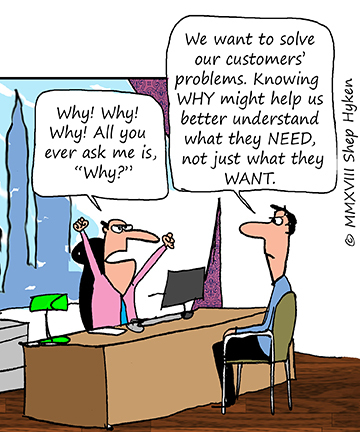 It’s morning and you’ve just had breakfast. What are you going to have for dinner? 49% of people in the U.S. do not know what they are going to have for dinner. That stat comes from David Portalatin’s address at the Art of Beef Summit, sponsored by Cargill. As he was addressing foodservice executives and salespeople, he emphasized that not knowing what’s for dinner, just hours before consumers are supposed to eat it, is a problem. Not for the foodservice people, but for consumers. They don’t know what they want, and whether they know it or not, they are looking for help. Not necessarily in the form of a plea for help, but in the form of wanting an easy and convenient way for them to decide what they are having for dinner.
It’s morning and you’ve just had breakfast. What are you going to have for dinner? 49% of people in the U.S. do not know what they are going to have for dinner. That stat comes from David Portalatin’s address at the Art of Beef Summit, sponsored by Cargill. As he was addressing foodservice executives and salespeople, he emphasized that not knowing what’s for dinner, just hours before consumers are supposed to eat it, is a problem. Not for the foodservice people, but for consumers. They don’t know what they want, and whether they know it or not, they are looking for help. Not necessarily in the form of a plea for help, but in the form of wanting an easy and convenient way for them to decide what they are having for dinner.
So, the customer’s problem becomes an opportunity for smart people in the food industry. Grocery stores are seeing an increase in numbers of their ready-to-eat meals prepared with fresh ingredients. Companies like Blue Apron and Hello Fresh, who deliver ready-to-prepare fresh meals, are seeing increases in sales. Then, of course, there are restaurants that make it easy. When the kids ask mom or dad, “What are you going to make for dinner?”, the most convenient answer when they don’t know just might be, “Reservations.”
The point is that these businesses aren’t just selling food. They are selling the solution to the problem of not knowing what’s for dinner. A grocer may sell food, but what the customer may want is the family dinner. A family taking dozens of pictures every day while on vacation isn’t looking to have a bunch of photographs. What they are after are memories.
Once you understand the “why” behind what you sell, you’ll start to be able to solve your customers’ problems. Questioning the “why” behind the “what,” you get a better understanding of what’s driving decisions, and as a result, can create a better customer experience.
Why does a person want a fancy red sports car? What’s driving that desire? Is all they want transportation? No. There is more to it than that. It might be congruent with the customer’s lively personality.
You may or may not know I’m hired to do keynote speeches at conferences around the world. Why do my clients want a speaker? Is it just the information? Absolutely not. If all they wanted was information, they would buy everyone a book. One of the first questions I like to ask my client when they are interested in having me speak is, “Why do you want to hire a professional speaker for your conference?” Another question is, “Why is the topic of customer service or customer experience important for this audience to hear?” The answers give me great insight into solving my client’s problems and needs for a program that will meet (ideally exceed) their expectations.
So, next time you are engaging in a conversation with your customers, think not just about what you’re talking about, but why you are talking about it.
Shep Hyken is a customer service and experience expert, award-winning keynote speaker, and New York Times bestselling business author. For information, contact 314-692-2200 or www.hyken.com. For information on The Customer Focus customer service training programs, go to www.thecustomerfocus.com. Follow on Twitter: @Hyken
customer service training programs, go to www.thecustomerfocus.com. Follow on Twitter: @Hyken
The post Want to be successful? Solve Your Customers’ Problems appeared first on Shep Hyken.
May 29, 2018
Amazing Business Radio: Gigi Butler

Create Your Own “Secret Ingredient” to Stand Out From Competition
How can you separate yourself from the competition?
Shep Hyken is joined by Gigi Butler, the founder of Gigi’s Cupcakes, the largest cupcake franchise in the world, to discuss how she differentiated herself from the competition.
>





Top Takeaways:
Branding is the experience a company offers, and to get people on board with a brand, a strong, passionate leader is necessary, along with a product people can connect with. In Butler’s case, she wants people to see, smell, and taste the passion she has for her cupcakes, whose recipes were passed down from generation to generation.
For Gigi’s Cupcakes, Butler wanted each cupcake to have its own personality, so her customers receive an immediate feeling, producing a memory. This is what differentiates one business from another. Companies must create products and experiences that connect with customers.
Butler’s book The Secret Ingredient , which is available for pre-order now, describes her journey from aspiring country music singer to cupcake entrepreneur. When music didn’t work out and she found herself cleaning other people’s homes (including Taylor Swift’s), she realized she should turn her passion—baking—into a business. Thus, Gigi’s Cupcakes was born.
If you want loyal customers, you need to remember that “one size does not fit all.” You need to provide options for everyone, even if it means allowing a customizable experience. This will ensure customers keep coming back. Butler does this by offering a wide variety – 278 flavors in Gigi’s Cupcakes’ catalog!
Something as simple as packaging plays an important role in the customer’s experience. Seeing recognizable packaging immediately makes you want that product. Your subconscious tells you there is something special inside it. For example, there is excitement and anticipation in opening the box that reveals your new iPhone – or, a delicious Gigi’s Cupcake.
Butler believes passion is a vital part of creating an excellent experience for customers. Without a purpose, it is nearly impossible to draw customers in and encourage them to come back.
Quotes:
“I think branding is, first of all, being recognizable and bringing joy.” – Gigi Butler
“When I did my packaging, I wanted it to be a little gift, something special inside.” – Gigi Butler
“It is all about passion, and it’s about selling what you believe, whether it’s a cupcake, a taco, a box or a phone.” – Gigi Butler
About:
Gigi Butler is the founder of Gigi’s Cupcakes, the largest cupcake franchise in the world with over 100 locations. Her book, The Secret Ingredient: Recipes for Success in Business and Life, is available for pre-order now.
Shep Hyken is a customer service and experience expert, New York Times bestselling author, award-winning keynote speaker, and your host of Amazing Business Radio.
This episode of Amazing Business Radio with Shep Hyken answers the following questions … and more:
How can you create an experience and a brand that people choose to follow?
Why should you be different for your customer?
How can I make impact on my customers?
Why is offering a variety of value to customers?
How can you provide your customers with the right packaging?
The post Amazing Business Radio: Gigi Butler appeared first on Shep Hyken.






